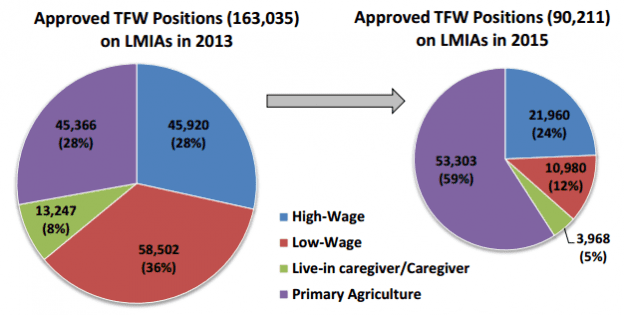Canada’s Temporary Foreign Worker Program: The Rules Have Changed

The Government of Canada recently made policy changes to its Temporary Foreign Worker Program. Among the announced changes, the program’s ‘4-in, 4-out’ rule will no longer apply. These changes will promote workforce stability and reduce hiring challenges faced by many Canadian employers.
What does ‘4-in, 4 out’ mean? The Temporary Foreign Worker Program’s ‘4-in, 4-out’ Policy limited how long migrant employees could work in Canada, forcing businesses to dismiss foreign workers after a maximum four years of cumulative employment. Effective immediately, Canadian businesses and temporary foreign workers will no longer be constrained by the 4-year cumulative duration policy.
Measures will still be taken to avoid the program’s abuse by Canadian employers. In fact, another new requirement of the program stipulates that low-wage employers will be expected to advertise their employment opportunities to 2-4 under-represented groups, such as persons with disabilities, youth workers, new immigrants and Indigenous people.
Changes to the Temporary Foreign Worker Program
The Temporary Foreign Worker (TFW) Program was created with the purpose of filling workforce talent gaps by hiring migrant workers on a temporary basis. In 2011, over 192,000 temporary foreign workers found employment in Canada. However, during that same year the ‘4-in, 4-out’ rule was imposed and by 2013 that amount had fallen to 163,035. By 2015 there were just slightly more than 90,000 temporary foreign workers.

Picture source: HUMA Report on the Temporary Foreign Worker Program
By eliminating the ‘4-in, 4-out’ rule, the Government of Canada is assisting businesses who struggle to fill seasonal positions that Canadian residents are not qualified for or uninterested in.
When the rule was implemented in 2011, it was meant to ensure that migrant employees weren’t taking jobs that would otherwise be filled by Canadian residents. Although Canada’s unemployment rate has climbed to 6.9%, businesses across the country are struggling to find Canadian residents to fill certain roles within their company.
Temporary foreign workers fill that void. By eliminating this rule, employers and foreign workers will now have a breadth of opportunities.
How Will These Changes Affect Employers?
Employers will benefit most from reduced labour shortages and the ability to sustain relationships with individual TFWs.
Some of the specific regulation changes that will affect employers include:
- New job promotion/advertising rules to ensure Canadians have first-hand access to employment opportunities;
- Harsher penalties, including monetary fines, for not complying with the program’s requirements;
- Increased inspections to avoid program abuse; and
- Reductions to the cap on the number of foreign workers an employer can have at a given time (now a maximum of 10%); and
- Dismissal of the ‘4-in, 4-out’ rule that forces TFWs to become ineligible for work in Canada after 4 years of cumulative service.
Please Note: Employers that accessed the TFW program prior to June 20, 2014 will still be eligible to employ 20% of foreign workers at a given worksite.
How Will These Changes Affect Temporary Foreign Workers?
The federal government’s decision to eliminate the ‘4-in, 4-out’ rule is a huge relief to foreign workers.
Some of the notable outcomes involve:
- Migrant employees will no longer be forced to return home and will have better access to permanent residency opportunities;
- Reduction in the number or foreign workers staying in Canada to work illegally; and
- Greater opportunities to find long-term employment within industries that have a shortage of skilled workers.
Sector Impacts Based on Changes to the Temporary Foreign Worker Program
Changes to the Temporary Foreign Worker Program will affect every sector differently. In Canada, agriculture, hospitality and tourism, and technology businesses are among those who may be impacted the most:
Canadian Agriculture: Changes to the TFW program will allow agriculture producers and processors to extend their growing/harvesting seasons and forecast product supply more accurately.
Hospitality & Tourism: Hospitality organizations such as hotels and banquet centres can respond to the seasonal demand surge in a practical way. This will reduce the strain on current employees and expand profitability during peak demand periods.
Advanced Technology: Employers will have greater access to international labourers; this expands the innovative abilities of technology developers and could result in the creation of new products or processes.
Government Programs to Hire or Immigrate Foreign Talent
The government offers other programs in addition to the Temporary Foreign Worker program, each with their own support system to help employers find foreign workers, including:
- Federal Express Entry Program: Helps expedite the immigration of foreign skilled workers by matching employers with qualified skilled workers, and accelerating the immigration process.
- Ontario Immigrant Nominee Program (OINP): Assists businesses attract foreign workers and recommend them for permanent residency through an accelerated process.
- GO Talent: Provides immigrants with labour market orientation, support, and referrals to Canadian tech businesses who are seeking skilled labourers.
Hiring and Training Resources for Small Businesses
Although the Temporary Foreign Worker Program has made it easier to keep TFWs for longer, employers must first show that there are no Canadian citizens available to fill the position.
There are two potential solutions to your workforce shortage problem that should first be considered before accessing resources such as the Temporary Foreign Worker Program.
- Hiring recent graduates as they join the workforce; and
- Train your employees to become more innovative, productive, etc.
Canadian government grants for hiring and training can provide a competitive edge to your workforce while ensuring Canadian citizens can staff the positions.
Related Post: 3 Hiring and Training Grants to Minimize Payroll Costs in 2017
Small Business Grants to Hire Skilled Post-Secondary Graduates
Hiring grants are available during spring and summer to help employers access the pool of recently graduated youth. These candidates can offer a range of benefits to your organization, and can be employed at reduced cost for up to one year. During this time, employers can provide practical experience to the employee, further enhancing their value.
Hiring grants can offset employee wages by up to 50% to a maximum $20,000. Depending on the funding stream, candidates must be hired for a minimum 4-12 months.
Training Grants to Improve Your Workforce’s Abilities
When used consistently as part of a comprehensive workforce development strategy, providing training can help employers stay up-to-date with current technologies and best-practices. Luckily, employers may access small business funding to offset a portion of third-party training costs.
The Canada Job Grant may provide up to 66% of training costs to a maximum grant of $10,000 per trainee. Small businesses with fewer than 50 employees, may be eligible for a contribution of up to 83% of costs.
Find Skilled Workers to Improve Your Labour Force
Discover how to attract desirable job prospects by accessing Mentor Works’ Recruiting Top Talent slide deck. In this resource, managers can compare top Canadian job boards and learn how Canadian government grants can be used to offset the costs of your new hire.

